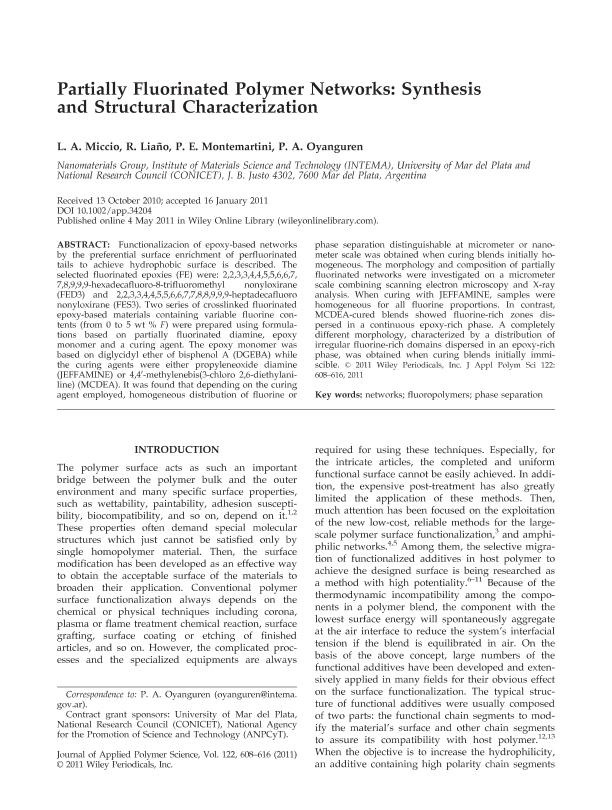Artículo
Partially fluorinated polymer networks: Synthesis and structural characterization
Fecha de publicación:
04/10/2011
Editorial:
Wiley
Revista:
Journal Of Applied Polymer Science
ISSN:
0021-8995
Idioma:
Inglés
Tipo de recurso:
Artículo publicado
Clasificación temática:
Resumen
Functionalizacion of epoxy-based networks by the preferential surface enrichment of perfluorinated tails to achieve hydrophobic surface is described. The selected fluorinated epoxies (FE) were: 2,2,3,3,4,4,5,5,6,6,7,7,8,9,9,9-hexadecafluoro-8-trifluoromethyl nonyloxirane (FED3) and 2,2,3,3,4,4,5,5,6,6,7,7,8,8,9,9,9-heptadecafluoro nonyloxirane (FES3). Two series of crosslinked fluorinated epoxy-based materials containing variable fluorine contents (from 0 to 5 wt % F) were prepared using formulations based on partially fluorinated diamine, epoxy monomer and a curing agent. The epoxy monomer was based on diglycidyl ether of bisphenol A (DGEBA) while the curing agents were either propyleneoxide diamine (JEFFAMINE) or 4,4′-methylenebis(3-chloro 2,6-diethylaniline) (MCDEA). It was found that depending on the curing agent employed, homogeneous distribution of fluorine or phase separation distinguishable at micrometer or nanometer scale was obtained when curing blends initially homogeneous. The morphology and composition of partially fluorinated networks were investigated on a micrometer scale combining scanning electron microscopy and X-ray analysis. When curing with JEFFAMINE, samples were homogeneous for all fluorine proportions. In contrast, MCDEA-cured blends showed fluorine-rich zones dispersed in a continuous epoxy-rich phase. A completely different morphology, characterized by a distribution of irregular fluorine-rich domains dispersed in an epoxy-rich phase, was obtained when curing blends initially immiscible.
Palabras clave:
Networks
,
Fluoropolymers
,
Phase Separation
Archivos asociados
Licencia
Identificadores
Colecciones
Articulos(INTEMA)
Articulos de INST.DE INV.EN CIENCIA Y TECNOL.MATERIALES (I)
Articulos de INST.DE INV.EN CIENCIA Y TECNOL.MATERIALES (I)
Citación
Miccio, Luis Alejandro; Liaño, Rocio; Montemartini, Pablo Ezequiel; Oyanguren, Patricia Angelica; Partially fluorinated polymer networks: Synthesis and structural characterization; Wiley; Journal Of Applied Polymer Science; 122; 1; 4-10-2011; 608-616
Compartir
Altmétricas




